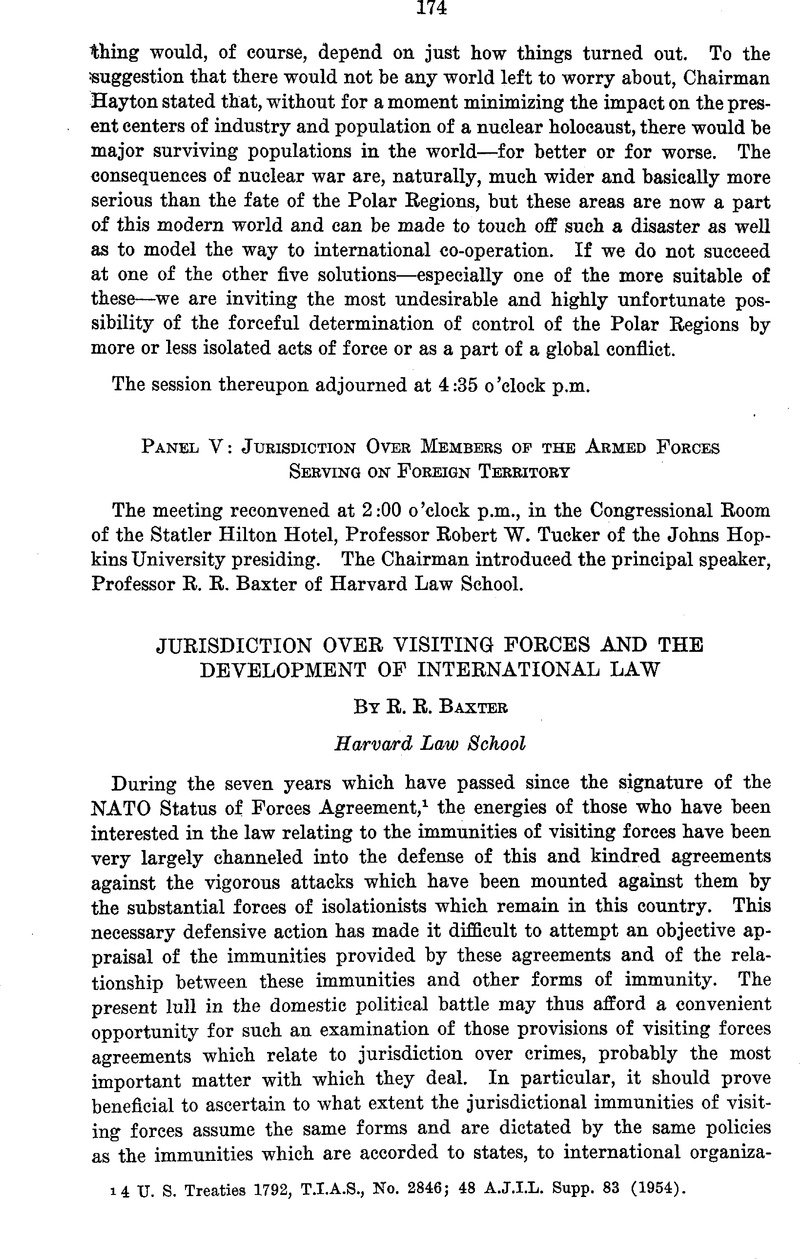Article contents
Jurisdiction Over Visiting Forces and the Development of International Law
Published online by Cambridge University Press: 27 February 2017
Abstract

- Type
- Fourth Session
- Information
- Proceedings of the American Society of International Law at its annual meeting (1921-1969) , Volume 52 , 1958 , pp. 174 - 180
- Copyright
- Copyright © American Society of International Law 1958
References
1 4 U. S. Treaties 1792, T.I.A.S., No. 2846; 48 A.J.I.L. Supp. 83 (1954).
2 Art. VII, par. 3.
3 Reid v Covert, 354 U. S. 1 (1957); cf. U. S. ex rel. Guagliardo v. McElroy, 158 F. Supp. 171 (D.D.C. 1958).
4 A consideration which, it is submitted, underlies the doctrines of act of state and of superior orders as well.
5 Hearings on H. J. Res. 309 and Similar Measures Before the House Committee on Foreign Affairs, 84th Cong., 1st Sess., Pt. 1 at 363–364 (1956).
6 Wilson et al. v. Girard, 354 U. S. 524 (1957).
7 Hearings to Review Operation of Article VII of the Agreement between the Parties to the North Atlantic Treaty Regarding the Status of Their Forces Before a Subcommittee of the Senate Committee on Armed Services, 84th Cong., 1st Sess. 10 (1955). For an example of such an agreement, see Agreement between the United States of America and the Kingdom of Greece concerning the Status of United States Forces in Greece, 7 U. S. Treaties 2555, T.I.A.S., No. 3649.
8 H.R. Rep. No. 678, 85th Cong., 1st Sess. 21 (1957).
9 See Barton, “Foreign Armed Forces: Immunity from Supervisory Jurisdiction,” 26 Brit. Year Book Int. Law 380 (1949); “Foreign Armed Forces: Immunity from Criminal Jurisdiction,” 27 ibid. 186 (1950); and “Foreign Armed Forces: Qualified Jurisdictional Immunity,” 31 ibid. 341 (1954); Schwartz, “International Law and the NATO Status of Forces Agreement,” 53 Col. Law Rev. 1091 (1953).
10 Art. VIII, par. 2(b).
11 Sen. Res. of July 15, 1953, 4 U. S. Treaties 1828, T.I.A.S., No. 1792 at 36.
12 E.g., the two important articles by Colonel King, “Jurisdiction over Friendly Foreign Armed Forces,” 36 A.J.I.L. 539 (1942), and “Further Developments Concerning Jurisdiction over Friendly Foreign Armed Forces,” 40 ibid. 257 (1946).
13 See Lauterpacht, , “The Problem of Jurisdictional Immunities of Foreign States,” 28 Brit. Year Book Int. Law 220 (1951)Google Scholar; and discussion above, pp. 80–113.
14 See U. S. note to the Ambassador of the U.S.S.R. of March 10, 1952, 26 Dept. of State Bulletin 451 (1952), imposing restrictions on the travel of Soviet officials in the United States in response to similar action by the U.S.S.R.
15 4 Eliz. 2, c. 21.
- 2
- Cited by


